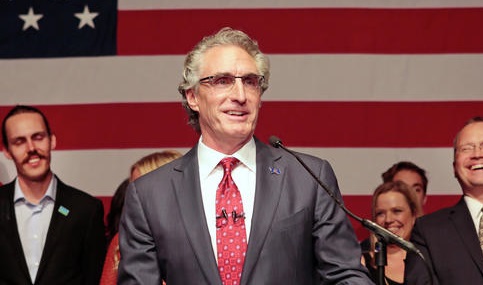
In North Dakota, GOP Governor Doug Burgum is taking action to grow jobs and develop a capable workforce. Determined to make his state more competitive, Governor Burgum is unleashing innovation and entrepreneurship, using technology and data to make the tough decisions, and as this new FORBES Q&A shows, his leadership has North Dakota on the right track for results.
FORBES reports:
Doug Burgum, North Dakota’s first-term Republican governor, has a unique background in software and venture capital. The North Dakota native and graduate of Stanford’s business school invested in tiny Great Plains Software in 1983 and became its CEO, growing the accounting software firm to 2,000 employees. In 1997 Great Plains went public, and in 2001 it was sold to Microsoft for $1.1 billion. Burgum later was an early investor in SuccessFactors, which sold to SAP for $3.4 billion in 2012, and Atlassian, a Sydney, Australia cloud software company that went public on the Nasdaq in 2015. Burgum served as Atlassian’s chairman before stepping down to run for governor in 2016.
Q: Why run for governor of North Dakota? When did you decide?
BURGUM: I’d been making payroll in North Dakota every two weeks from the time I was 26 years old. I had 30 years of experience in hiring and trying to attract talent and capital back to North Dakota. And any time someone talks about the future of North Dakota, what are the challenges? Where do we get the talent, and where do we get the capital? Well, that’s what I’ve been dealing with my whole working career. I thought, wouldn’t it be great to run a state like that—to develop talent and attract capital?
Q: But you had never run for elected office.
BURGUM: That’s not a bad thing in North Dakota. The previous three governors had all been business guys. I was at a board meeting in San Francisco for Atlassian when Governor Jack Dalrymple announced that he wasn’t running again. The Fargo Forum tracked me down to ask, “Would you ever throw your hat in the ring?” And, without any hesitation whatsoever, I responded, “I wouldn’t rule it out.”
Q: When was that?
BURGUM: August 2015. Atlassian was on its final quarter before going public, and I wanted to see that through. I also had other obligations at Arthur Ventures [Burgum’s Fargo-based venture capital firm that he runs with his nephew, James Burgum].
Q: So what finally tipped you to run?
BURGUM: Technology is changing every job, every company and every industry—or soon will be. The next frontiers are education, health care, transportation—and the government touches all of these things. Doesn’t it make sense to have an elected leader who gets it? So we built a campaign around a new leader for a changing economy.
Q: How did you run your campaign?
BURGUM: We went to every town in North Dakota with a population of 1,000 or more—and a lot of them were even smaller. I didn’t give stump speeches. Instead, I’d invite the mayor, the city council, the school superintendent, the person who runs the nursing home, any Main Street business leaders and whoever else wanted to come. And I’d ask, “What’s going on here?” And I filled notebook after notebook with answers and thoughts. Sometimes I’d go to a town and only 5 people would show up. But then all of sudden there were 20 and 30, and by the end there were 90 people showing up.
Q: You believe transparent data, presented simply, can solve a lot of arguments.
BURGUM: Yes. My mantra about government data is: “It’s the people’s data.” The taxpayers have a right to see the data–where their money is going and how decisions are made. When you’re talking any kind of budget item, you need to show people the data. Things that look like a good idea can be very expensive in the long run. For example, new roads to expand a city sound like a good idea. But new roads also mean a new maintenance liability; roads don’t repair themselves. The data will usually show that repairing existing roads closer to the center of town is a better bet.
Here’s another example. We did a quick analysis with the GIS map for Fargo. We figured out that there were 242,000 off-street parking spots, just from a quick view of an aerial map. So, if you’re positing that Fargo needs a new $1.2 million parking garage, the data shows the case for that isn’t strong. A better solution might be to have more buses and/or ride-sharing apps.”
Q: What would you consider a win after four years as governor?
BURGUM: The biggest win would be in workforce development. Right now we’ve got low unemployment, but we also have 15,000 jobs open in North Dakota. That’s the equivalent of having 750,000 jobs open in California.
Every one of those jobs, once it’s filled, becomes a tax contributor. So the priority of government should be in finding ways to help every private company fill every job they want to fill. Starting there will lead to all kinds of policy stuff. I’ve told my team that if we get nothing else done in the next four years but fill every job that’s available in North Dakota, that will be a huge win.





See the latest videos from RGA
Watch our videosNEW from @GovernorKayIvey: “The CHOOSE Act is putting Alabama parents in the driver’s seat of their child’s education.
I believe it will be one of the most successful school choice programs in the country.”
https://aldailynews.com/ivey-the-choose-act-alabamas-education-savings-account-program-puts-parents-in-the-drivers-seat/
Welcome to a state led by common sense!
@iamwesmoore loses to @GovernorVA again.
What a day for Virginia! @HUDgov is relocating its headquarters to the Commonwealth, bringing over 2,700 employees to its new home in Alexandria.
Thank you @SecretaryTurner for your trust and leadership. We’re proud to welcome HUD to the best state in America to live, work, and https://t.co/DLvdgqy8hY
Follow RGA on Twitter
Follow RGA on Facebook